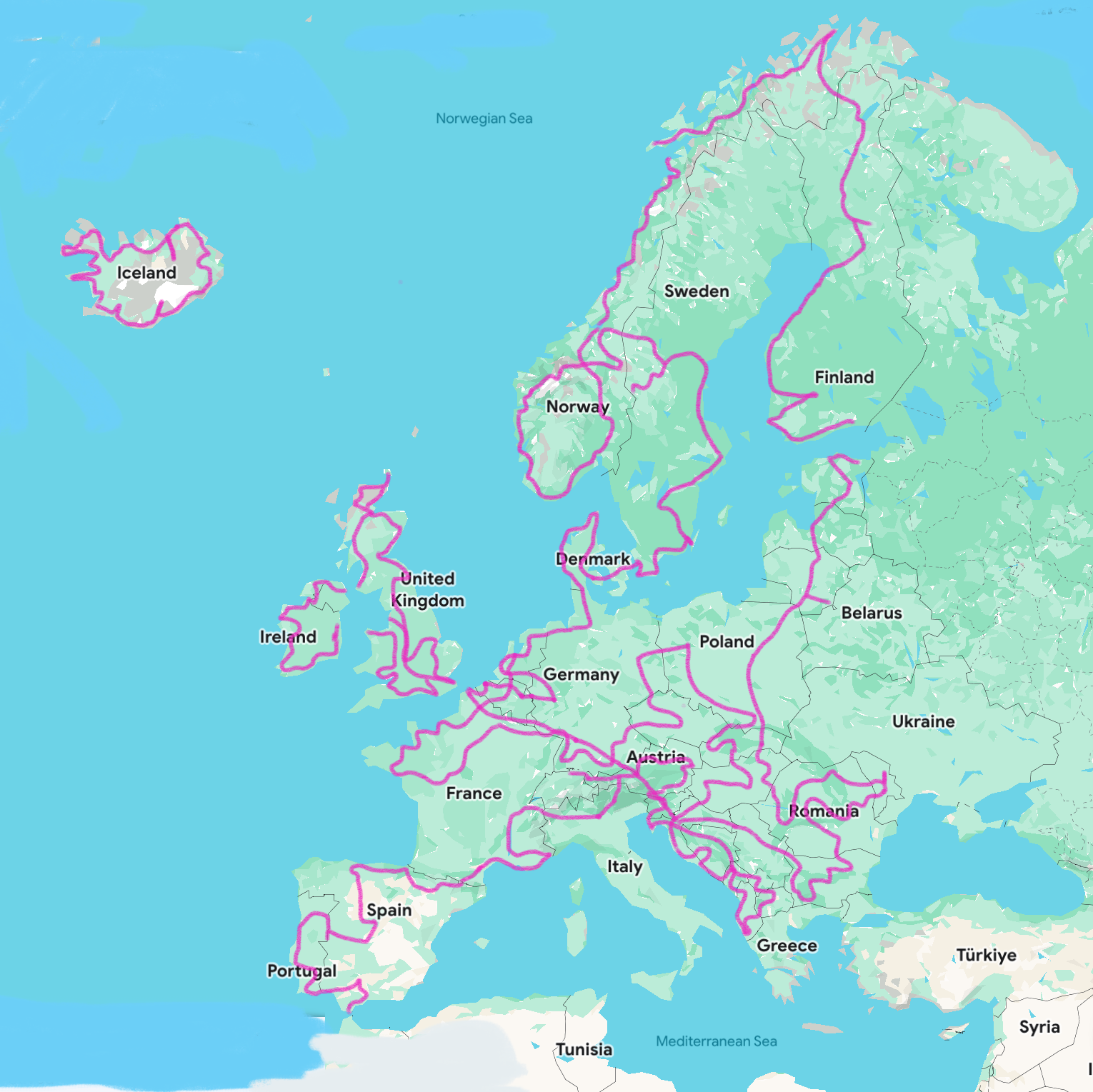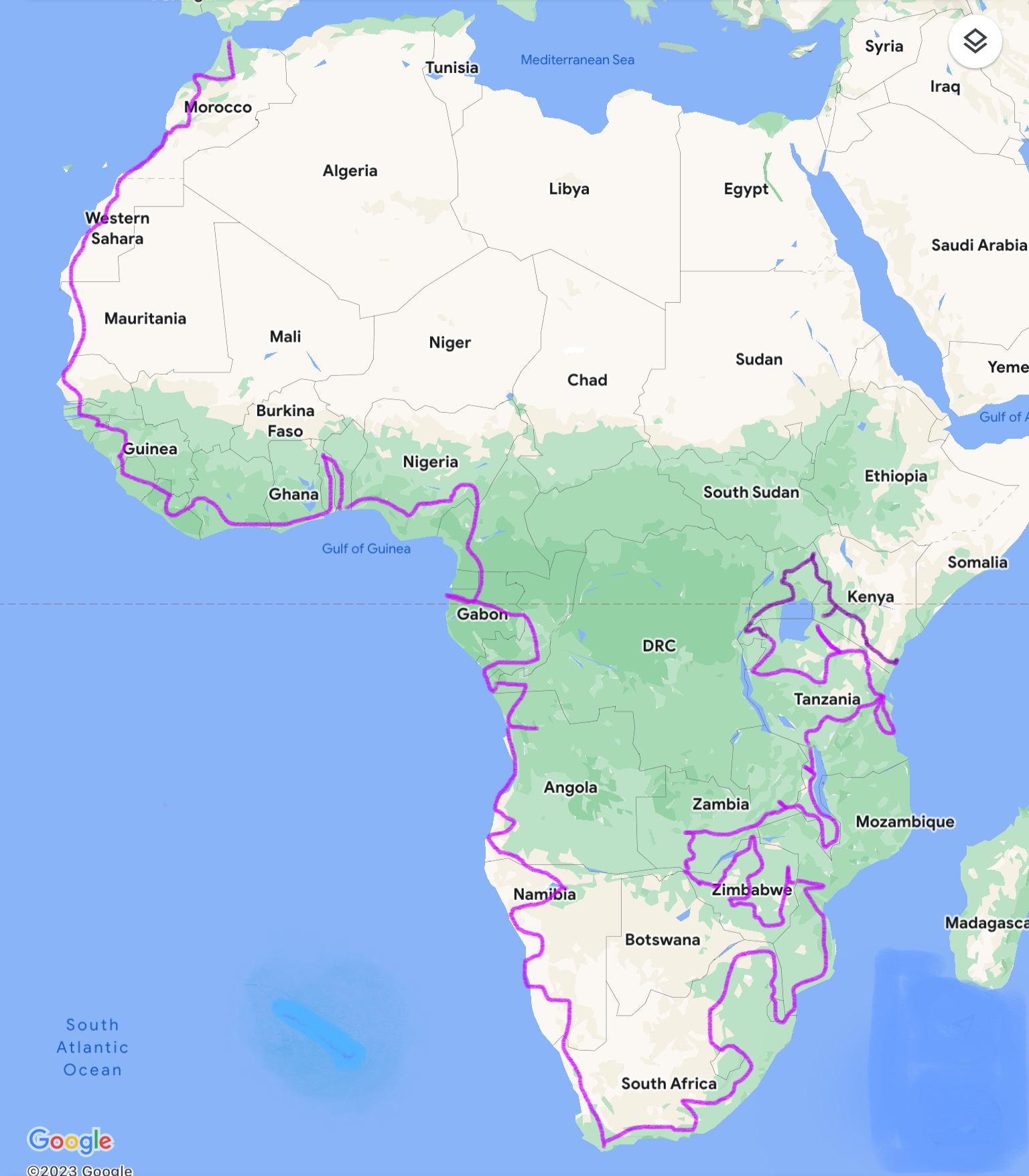tacototheworld
Well-known member
Tajikistan and the Pamir Highway - Part 1
![[IMG] [IMG]](https://images.squarespace-cdn.com/content/v1/5eb85920d2ae880e0ff1526f/a29de347-c94e-4759-ad15-e89196cac741/PXL_20240917_103156449%7E2.jpg)
Driving the Pamir Highway, Tajikistan
Tajikistan embodied all the greatest aspects of overlanding adventure for us. It had vast open country, stark majestic mountains, a culture and history that was different and new for us to learn. Tajikistan provided remote and wild terrain, we could not wait to explore its high desert mountains and fulfill a lifelong dream of driving the Pamir Highway.
As with the neighboring countries of Central Asia, the Tajik people were warm and welcoming, but outside of the bigger cities tourism infrastructure was surprisingly limited. Family run homestays were the norm along the Pamir highway with groceries hard to find outside of very small convenience stores carrying dry goods, soda and cookies. ATM’s were scarce but gas stations were common enough to get us by with some planning.
![[IMG] [IMG]](https://images.squarespace-cdn.com/content/v1/5eb85920d2ae880e0ff1526f/83e63df0-fbd7-454f-aade-0729bf1f62ea/Tajikistan.jpg)
Our 2100km route through Tajikistan
The first place we explored was the gorgeous Fann Mountain region.
![[IMG] [IMG]](https://images.squarespace-cdn.com/content/v1/5eb85920d2ae880e0ff1526f/e7331b7c-be55-44fa-8ff3-d7330836c02c/PXL_20240906_125250083%7E2.jpg)
Sun goes down on camp while Dawn (with Andy's encouragement) poses a little awkwardly on the hood
![[IMG] [IMG]](https://images.squarespace-cdn.com/content/v1/5eb85920d2ae880e0ff1526f/b4f08fcd-4a3c-46f9-af8a-fe824ca29d11/PXL_20240907_040023376%7E2.jpg)
The road was narrow - we were glad we only met one vehicle
![[IMG] [IMG]](https://images.squarespace-cdn.com/content/v1/5eb85920d2ae880e0ff1526f/b01e92c1-b110-48b2-aa4b-d48a2e76eb57/PXL_20240906_111837199_exported_4801%7E2.jpg)
Passing through villages, school children always beautifully dressed in black and white, the girls with huge white bows in their hair
![[IMG] [IMG]](https://images.squarespace-cdn.com/content/v1/5eb85920d2ae880e0ff1526f/e5b8bd3c-c24d-4390-8e94-2c848081f8f1/PXL_20240907_061204195%7E2.jpg)
Some with beautiful designs in the walls
![[IMG] [IMG]](https://images.squarespace-cdn.com/content/v1/5eb85920d2ae880e0ff1526f/9471ea9b-53f0-443e-b56f-dabccc9fa6fa/PXL_20240907_062412073.RAW-01.COVER%7E3.jpg)
Each of the seven lakes a different, glorious blue
People, especially children, in Tajikistan went out of their way to welcome us as we passed through their villages. Children would run out and wave and call out “hello” or “welcome!” We always felt safe, whether in the city or in a really remote area.
The next drive we ventured on was into Alauddin Lake near Sarvoda. It was another area steeped in beauty, rural village life side by side with spectacular hiking and scenery.
![[IMG] [IMG]](https://images.squarespace-cdn.com/content/v1/5eb85920d2ae880e0ff1526f/8aa38ed7-4529-4fe0-8a90-97b1ee9f79e1/PXL_20240908_055853327%7E2.jpg)
More donkeys than vehicles on the road to Alauddin Lake
![[IMG] [IMG]](https://images.squarespace-cdn.com/content/v1/5eb85920d2ae880e0ff1526f/7aa3ae20-8f29-485e-a5b6-b00c67e8f0c5/PXL_20240908_103538676.RAW-01.COVER%7E2.jpg)
![[IMG] [IMG]](https://images.squarespace-cdn.com/content/v1/5eb85920d2ae880e0ff1526f/12b92fa7-addc-47bc-9e00-99910e6e49a9/PXL_20240908_115003036%7E2.jpg)
Carved door at a village home
![[IMG] [IMG]](https://images.squarespace-cdn.com/content/v1/5eb85920d2ae880e0ff1526f/09eb75ba-79c2-4de3-ae91-c57d93375ada/PXL_20240908_135139837%7E3.jpg)
Sunset view from camp
![[IMG] [IMG]](https://images.squarespace-cdn.com/content/v1/5eb85920d2ae880e0ff1526f/a728021e-89bb-44f9-9042-0a703cc2c6a4/PXL_20240909_045613035%7E3.jpg)
That's a lot of sheep and goats in the road! Shepherds still moving the flocks before winter.
Our souls enriched with mountain scenery and air, it was time to head to the big city to pick up our son, Nicholas. We were thrilled that he would be joining us on the road for a month. It was also an opportunity to re-supply the truck before we headed out on the Pamir HIghway.
Dushanbe was not our favorite city. It was easy to navigate with wide tree lined streets, orderly and clean. But it also felt inauthentic somehow. The downtown buildings were new and ornate, many displaying giant posters with pictures of the president who has been in power for 33 years and has a questionable human rights record.
![[IMG] [IMG]](https://images.squarespace-cdn.com/content/v1/5eb85920d2ae880e0ff1526f/ce3f65ef-ee08-423e-975a-9c61b5f074b9/PXL_20240910_062457385.jpg)
Monument to Ismail Somoni, a revered leader of the Samanid dynasty which included what is now Tajikistan in the early 900's.
Pamir Highway - Tajikistan Section
We kept detailed notes from our trip as we found it was relatively hard to get specific information about routes, timing, places to stay, etc. Below is our day by day breakdown in case it is useful to others.
![[IMG] [IMG]](https://images.squarespace-cdn.com/content/v1/5eb85920d2ae880e0ff1526f/8c6b9171-3a2a-4fd2-bbe0-76af9533ec99/pamir+highway.png)
Map of the Pamir Region and routes from the Caravanistan website, which we found to be an extremely helpful resource.
The classic Pamir HIghway Dushanbe, Tajikistan to Osh, Kyrgystan. But there are a number of variations and side routes that people incorporate.
The first decision point upon leaving Dushanbe is whether to take the northern, Tavildara route (more remote and over a 10,700 ft mountain pass) or to go through Kulob which is a better road, slightly shorter in time but longer in miles (if you believe Google). As our weather was good and we always love the mountains, we took the northern route to Kalaikhum.
From Khorog, you can choose to take the direct Pamir HIghway route (M41) - the red route above - or head south along the border with Afghanistan for a more remote route. After speaking to locals and fellow travelers, we opted to take the southern, Wakhan Valley road - the brown road above - which locals commonly refer to as “the real Pamir.”
We took eleven days to go from Dushanbe, Tajikistan to Sary Tosh, Kyrgystan. We did not continue driving north to Osh at this point, but peeled east to enter China. We were traveling the Pamir route Sept 11- 20, 2024.
Day 1 - 165 km, 4.5 hours of driving
We left Dushanbe at 11:30am, arrived at camp about 5pm. (We were using iOverlander to find wild spots to make sure we didn’t accidentally camp somewhere we were not supposed to. ) The more northern route (blue road on map above) was mostly decent, but at times deteriorated to gravel and forced us to reduce speed to about 15kph.
In general, along the route we drove, road conditions were rough enough to slow you down (gravel, if asphalt then potholes to watch for) but never severe enough that you needed hardcore 4x4.
Throughout this first day, the scenery got better and better as we approached the mountains and started passing through canyons.
Day 2 - 178km, 7 hours of driving
On the second day we drove over the mountain pass and through Kalaikhum (shown as Qalai Khumb on map above). A big challenge for overlanders during this time was massive construction delays on the Pamir Highway stretching from south of Kalaikhum to Khorog. Someday, maybe in a year, the road will be smooth going, but for now traffic is stopped for anywhere from 2-6 hours intermittently along the way as construction crews blast out the rock cliffs to widen the road. Locals advised us to get up early and try to get as much of the road as possible before crews showed up at 8am.
The Tajikistan military were very active along this section. There were regular military check points (just friendly passport checks), frequent military bases and patrols.
![[IMG] [IMG]](https://images.squarespace-cdn.com/content/v1/5eb85920d2ae880e0ff1526f/19f6b94e-4896-42e4-b6c8-9769059ffe72/original_b5d50850-436d-4442-9ab4-a7d190226765_PXL_20240912_094756097.jpg)
Regular military patrols along the border with Afghanistan - the border is the river
![[IMG] [IMG]](https://images.squarespace-cdn.com/content/v1/5eb85920d2ae880e0ff1526f/dc5ed12d-f917-4592-b919-64704a890118/PXL_20240912_120059544.jpg)
Construction delay - everyone just sits and waits
Day 3 -144 km, 5 hours of driving
We managed to get out of camp early - 6:15am and get through the rest of the construction zone with no delays. Having spent a couple of long hard driving days, we headed to Jizeu Valley for scenery and hiking.
![[IMG] [IMG]](https://images.squarespace-cdn.com/content/v1/5eb85920d2ae880e0ff1526f/03ff47e9-2437-46ec-8dfa-4313490aabc5/original_edda4b0f-d850-4a9b-9ed4-cdc0d43b98c7_PXL_20240913_031540353.jpg)
Looking across the river to villages on the Afghanistan side
![[IMG] [IMG]](https://images.squarespace-cdn.com/content/v1/5eb85920d2ae880e0ff1526f/b25adbab-26ed-4dca-9aae-c697fca186af/PXL_20240913_013907278%7E2.jpg)
Scenery across the road
![[IMG] [IMG]](https://images.squarespace-cdn.com/content/v1/5eb85920d2ae880e0ff1526f/cd2670e2-a100-4ec4-ac3f-1ddf1a13c051/IMG_4093.jpg)
Bhartang Valley road - along a glacial river
![[IMG] [IMG]](https://images.squarespace-cdn.com/content/v1/5eb85920d2ae880e0ff1526f/d83b52a9-ce83-4bb8-8cf6-5eac878aae78/PXL_20240913_085209863%7E2.jpg)
And who should pull up to say "hi" but a French overlander with a Toyota Tacoma with a 4 Wheel Camper!! He ordered both from the US.
Stay tuned for part 2!
![[IMG] [IMG]](https://images.squarespace-cdn.com/content/v1/5eb85920d2ae880e0ff1526f/a29de347-c94e-4759-ad15-e89196cac741/PXL_20240917_103156449%7E2.jpg)
Driving the Pamir Highway, Tajikistan
Tajikistan embodied all the greatest aspects of overlanding adventure for us. It had vast open country, stark majestic mountains, a culture and history that was different and new for us to learn. Tajikistan provided remote and wild terrain, we could not wait to explore its high desert mountains and fulfill a lifelong dream of driving the Pamir Highway.
As with the neighboring countries of Central Asia, the Tajik people were warm and welcoming, but outside of the bigger cities tourism infrastructure was surprisingly limited. Family run homestays were the norm along the Pamir highway with groceries hard to find outside of very small convenience stores carrying dry goods, soda and cookies. ATM’s were scarce but gas stations were common enough to get us by with some planning.
![[IMG] [IMG]](https://images.squarespace-cdn.com/content/v1/5eb85920d2ae880e0ff1526f/83e63df0-fbd7-454f-aade-0729bf1f62ea/Tajikistan.jpg)
Our 2100km route through Tajikistan
The first place we explored was the gorgeous Fann Mountain region.
![[IMG] [IMG]](https://images.squarespace-cdn.com/content/v1/5eb85920d2ae880e0ff1526f/e7331b7c-be55-44fa-8ff3-d7330836c02c/PXL_20240906_125250083%7E2.jpg)
Sun goes down on camp while Dawn (with Andy's encouragement) poses a little awkwardly on the hood
![[IMG] [IMG]](https://images.squarespace-cdn.com/content/v1/5eb85920d2ae880e0ff1526f/b4f08fcd-4a3c-46f9-af8a-fe824ca29d11/PXL_20240907_040023376%7E2.jpg)
The road was narrow - we were glad we only met one vehicle
![[IMG] [IMG]](https://images.squarespace-cdn.com/content/v1/5eb85920d2ae880e0ff1526f/b01e92c1-b110-48b2-aa4b-d48a2e76eb57/PXL_20240906_111837199_exported_4801%7E2.jpg)
Passing through villages, school children always beautifully dressed in black and white, the girls with huge white bows in their hair
![[IMG] [IMG]](https://images.squarespace-cdn.com/content/v1/5eb85920d2ae880e0ff1526f/e5b8bd3c-c24d-4390-8e94-2c848081f8f1/PXL_20240907_061204195%7E2.jpg)
Some with beautiful designs in the walls
![[IMG] [IMG]](https://images.squarespace-cdn.com/content/v1/5eb85920d2ae880e0ff1526f/9471ea9b-53f0-443e-b56f-dabccc9fa6fa/PXL_20240907_062412073.RAW-01.COVER%7E3.jpg)
Each of the seven lakes a different, glorious blue
People, especially children, in Tajikistan went out of their way to welcome us as we passed through their villages. Children would run out and wave and call out “hello” or “welcome!” We always felt safe, whether in the city or in a really remote area.
The next drive we ventured on was into Alauddin Lake near Sarvoda. It was another area steeped in beauty, rural village life side by side with spectacular hiking and scenery.
![[IMG] [IMG]](https://images.squarespace-cdn.com/content/v1/5eb85920d2ae880e0ff1526f/8aa38ed7-4529-4fe0-8a90-97b1ee9f79e1/PXL_20240908_055853327%7E2.jpg)
More donkeys than vehicles on the road to Alauddin Lake
![[IMG] [IMG]](https://images.squarespace-cdn.com/content/v1/5eb85920d2ae880e0ff1526f/7aa3ae20-8f29-485e-a5b6-b00c67e8f0c5/PXL_20240908_103538676.RAW-01.COVER%7E2.jpg)
![[IMG] [IMG]](https://images.squarespace-cdn.com/content/v1/5eb85920d2ae880e0ff1526f/12b92fa7-addc-47bc-9e00-99910e6e49a9/PXL_20240908_115003036%7E2.jpg)
Carved door at a village home
![[IMG] [IMG]](https://images.squarespace-cdn.com/content/v1/5eb85920d2ae880e0ff1526f/09eb75ba-79c2-4de3-ae91-c57d93375ada/PXL_20240908_135139837%7E3.jpg)
Sunset view from camp
![[IMG] [IMG]](https://images.squarespace-cdn.com/content/v1/5eb85920d2ae880e0ff1526f/a728021e-89bb-44f9-9042-0a703cc2c6a4/PXL_20240909_045613035%7E3.jpg)
That's a lot of sheep and goats in the road! Shepherds still moving the flocks before winter.
Our souls enriched with mountain scenery and air, it was time to head to the big city to pick up our son, Nicholas. We were thrilled that he would be joining us on the road for a month. It was also an opportunity to re-supply the truck before we headed out on the Pamir HIghway.
Dushanbe was not our favorite city. It was easy to navigate with wide tree lined streets, orderly and clean. But it also felt inauthentic somehow. The downtown buildings were new and ornate, many displaying giant posters with pictures of the president who has been in power for 33 years and has a questionable human rights record.
![[IMG] [IMG]](https://images.squarespace-cdn.com/content/v1/5eb85920d2ae880e0ff1526f/ce3f65ef-ee08-423e-975a-9c61b5f074b9/PXL_20240910_062457385.jpg)
Monument to Ismail Somoni, a revered leader of the Samanid dynasty which included what is now Tajikistan in the early 900's.
Pamir Highway - Tajikistan Section
We kept detailed notes from our trip as we found it was relatively hard to get specific information about routes, timing, places to stay, etc. Below is our day by day breakdown in case it is useful to others.
![[IMG] [IMG]](https://images.squarespace-cdn.com/content/v1/5eb85920d2ae880e0ff1526f/8c6b9171-3a2a-4fd2-bbe0-76af9533ec99/pamir+highway.png)
Map of the Pamir Region and routes from the Caravanistan website, which we found to be an extremely helpful resource.
The classic Pamir HIghway Dushanbe, Tajikistan to Osh, Kyrgystan. But there are a number of variations and side routes that people incorporate.
The first decision point upon leaving Dushanbe is whether to take the northern, Tavildara route (more remote and over a 10,700 ft mountain pass) or to go through Kulob which is a better road, slightly shorter in time but longer in miles (if you believe Google). As our weather was good and we always love the mountains, we took the northern route to Kalaikhum.
From Khorog, you can choose to take the direct Pamir HIghway route (M41) - the red route above - or head south along the border with Afghanistan for a more remote route. After speaking to locals and fellow travelers, we opted to take the southern, Wakhan Valley road - the brown road above - which locals commonly refer to as “the real Pamir.”
We took eleven days to go from Dushanbe, Tajikistan to Sary Tosh, Kyrgystan. We did not continue driving north to Osh at this point, but peeled east to enter China. We were traveling the Pamir route Sept 11- 20, 2024.
Day 1 - 165 km, 4.5 hours of driving
We left Dushanbe at 11:30am, arrived at camp about 5pm. (We were using iOverlander to find wild spots to make sure we didn’t accidentally camp somewhere we were not supposed to. ) The more northern route (blue road on map above) was mostly decent, but at times deteriorated to gravel and forced us to reduce speed to about 15kph.
In general, along the route we drove, road conditions were rough enough to slow you down (gravel, if asphalt then potholes to watch for) but never severe enough that you needed hardcore 4x4.
Throughout this first day, the scenery got better and better as we approached the mountains and started passing through canyons.
Day 2 - 178km, 7 hours of driving
On the second day we drove over the mountain pass and through Kalaikhum (shown as Qalai Khumb on map above). A big challenge for overlanders during this time was massive construction delays on the Pamir Highway stretching from south of Kalaikhum to Khorog. Someday, maybe in a year, the road will be smooth going, but for now traffic is stopped for anywhere from 2-6 hours intermittently along the way as construction crews blast out the rock cliffs to widen the road. Locals advised us to get up early and try to get as much of the road as possible before crews showed up at 8am.
The Tajikistan military were very active along this section. There were regular military check points (just friendly passport checks), frequent military bases and patrols.
![[IMG] [IMG]](https://images.squarespace-cdn.com/content/v1/5eb85920d2ae880e0ff1526f/19f6b94e-4896-42e4-b6c8-9769059ffe72/original_b5d50850-436d-4442-9ab4-a7d190226765_PXL_20240912_094756097.jpg)
Regular military patrols along the border with Afghanistan - the border is the river
![[IMG] [IMG]](https://images.squarespace-cdn.com/content/v1/5eb85920d2ae880e0ff1526f/dc5ed12d-f917-4592-b919-64704a890118/PXL_20240912_120059544.jpg)
Construction delay - everyone just sits and waits
Day 3 -144 km, 5 hours of driving
We managed to get out of camp early - 6:15am and get through the rest of the construction zone with no delays. Having spent a couple of long hard driving days, we headed to Jizeu Valley for scenery and hiking.
![[IMG] [IMG]](https://images.squarespace-cdn.com/content/v1/5eb85920d2ae880e0ff1526f/03ff47e9-2437-46ec-8dfa-4313490aabc5/original_edda4b0f-d850-4a9b-9ed4-cdc0d43b98c7_PXL_20240913_031540353.jpg)
Looking across the river to villages on the Afghanistan side
![[IMG] [IMG]](https://images.squarespace-cdn.com/content/v1/5eb85920d2ae880e0ff1526f/b25adbab-26ed-4dca-9aae-c697fca186af/PXL_20240913_013907278%7E2.jpg)
Scenery across the road
![[IMG] [IMG]](https://images.squarespace-cdn.com/content/v1/5eb85920d2ae880e0ff1526f/cd2670e2-a100-4ec4-ac3f-1ddf1a13c051/IMG_4093.jpg)
Bhartang Valley road - along a glacial river
![[IMG] [IMG]](https://images.squarespace-cdn.com/content/v1/5eb85920d2ae880e0ff1526f/d83b52a9-ce83-4bb8-8cf6-5eac878aae78/PXL_20240913_085209863%7E2.jpg)
And who should pull up to say "hi" but a French overlander with a Toyota Tacoma with a 4 Wheel Camper!! He ordered both from the US.
Stay tuned for part 2!
Last edited:

![[IMG] [IMG]](https://images.squarespace-cdn.com/content/v1/5eb85920d2ae880e0ff1526f/58aec078-96ea-4758-ba83-3ba3600d6eaa/IMG_4102.jpg)
![[IMG] [IMG]](https://images.squarespace-cdn.com/content/v1/5eb85920d2ae880e0ff1526f/4cad0567-51b1-4136-89d5-573bc8450adb/PXL_20240914_060835515%7E2.jpg)
![[IMG] [IMG]](https://images.squarespace-cdn.com/content/v1/5eb85920d2ae880e0ff1526f/3e1fbb19-2463-4394-9749-2ed9068e7bdc/PXL_20240914_082449624%7E2.jpg)
![[IMG] [IMG]](https://images.squarespace-cdn.com/content/v1/5eb85920d2ae880e0ff1526f/f0dfc475-c676-460f-8817-1836e36e331b/PXL_20240915_041920629.jpg)
![[IMG] [IMG]](https://images.squarespace-cdn.com/content/v1/5eb85920d2ae880e0ff1526f/b693442b-5691-4347-99ed-4e4fc5decb55/PXL_20240915_083937758%7E3.jpg)
![[IMG] [IMG]](https://images.squarespace-cdn.com/content/v1/5eb85920d2ae880e0ff1526f/f33410c6-d4b1-4ed3-8b75-1b0bb2d7b549/original_615c196a-93bb-43d4-80c7-48c72a70a005_PXL_20240915_105207523.jpg)
![[IMG] [IMG]](https://images.squarespace-cdn.com/content/v1/5eb85920d2ae880e0ff1526f/435740c9-84ef-49ee-be4e-f80a1a840c3e/PXL_20240915_131431065%7E2.jpg)
![[IMG] [IMG]](https://images.squarespace-cdn.com/content/v1/5eb85920d2ae880e0ff1526f/f1f675c6-1f7c-4489-bb04-bdf43a4eb34f/PXL_20240916_062820327%7E2.jpg)
![[IMG] [IMG]](https://images.squarespace-cdn.com/content/v1/5eb85920d2ae880e0ff1526f/e00b0964-908d-4a19-a438-bcfe7defc0af/PXL_20240916_090904091%7E2.jpg)
![[IMG] [IMG]](https://images.squarespace-cdn.com/content/v1/5eb85920d2ae880e0ff1526f/029303e0-964d-4b88-bdde-123657edaebd/PXL_20240917_054013780.RAW-01.COVER.jpg)
![[IMG] [IMG]](https://images.squarespace-cdn.com/content/v1/5eb85920d2ae880e0ff1526f/012b20be-9d2a-421d-9b6f-f1a8fbc17167/PXL_20240917_084307929.RAW-01.COVER%7E2.jpg)
![[IMG] [IMG]](https://images.squarespace-cdn.com/content/v1/5eb85920d2ae880e0ff1526f/b6cca30a-5cc4-4bb4-a370-11e5c77f164d/PXL_20240917_085539573.RAW-01.COVER.jpg)
![[IMG] [IMG]](https://images.squarespace-cdn.com/content/v1/5eb85920d2ae880e0ff1526f/d5bfa7b6-3f3f-482d-afdd-42b689a142c4/PXL_20240917_100808346%7E2.jpg)
![[IMG] [IMG]](https://images.squarespace-cdn.com/content/v1/5eb85920d2ae880e0ff1526f/6aa55cc2-abc5-4568-96a9-872ec8ab1350/PXL_20240918_093942728%7E2.jpg)
![[IMG] [IMG]](https://images.squarespace-cdn.com/content/v1/5eb85920d2ae880e0ff1526f/3c1a44d0-ebd3-4c54-9986-ba2e351a7fd4/PXL_20240918_082751083.jpg)
![[IMG] [IMG]](https://images.squarespace-cdn.com/content/v1/5eb85920d2ae880e0ff1526f/b9818386-ed52-4eb6-b198-c56f38f85e9b/original_7baf2fb0-fbd7-49ec-bb98-054cbbc79b41_PXL_20240918_115841429.RAW-01.COVER%7E2.jpg)
![[IMG] [IMG]](https://images.squarespace-cdn.com/content/v1/5eb85920d2ae880e0ff1526f/2855fac7-26dd-4c69-bb60-6e98c2a7d187/PXL_20240919_023804277%7E2.jpg)
![[IMG] [IMG]](https://images.squarespace-cdn.com/content/v1/5eb85920d2ae880e0ff1526f/a3e0bcee-0b11-4b59-b88a-e9542c22d1c4/PXL_20240919_040849112%7E2.jpg)
![[IMG] [IMG]](https://images.squarespace-cdn.com/content/v1/5eb85920d2ae880e0ff1526f/640f719c-4dd7-4b63-b63a-ba967e629f13/PXL_20240919_134314533%7E2.jpg)
![[IMG] [IMG]](https://images.squarespace-cdn.com/content/v1/5eb85920d2ae880e0ff1526f/0a7f9d38-3600-40cc-b5d5-26282c93285b/PXL_20240920_062032595%7E2.jpg)


![[IMG] [IMG]](https://images.squarespace-cdn.com/content/v1/5eb85920d2ae880e0ff1526f/e83f4d9e-2bbc-4fd2-9920-223e1b4d1fed/PXL_20240902_063818903%7E2.jpg)
![[IMG] [IMG]](https://images.squarespace-cdn.com/content/v1/5eb85920d2ae880e0ff1526f/0896db3d-d2ec-4b1a-9be3-858cd4fe5374/kyrg-chin.jpg)
![[IMG] [IMG]](https://images.squarespace-cdn.com/content/v1/5eb85920d2ae880e0ff1526f/8ec15ac0-9a4c-4df9-83b1-6de7d84da643/PXL_20240829_095548282%7E2.jpg)
![[IMG] [IMG]](https://images.squarespace-cdn.com/content/v1/5eb85920d2ae880e0ff1526f/41a193b3-e733-4bfa-baa7-86b960e92935/PXL_20240829_100332770.jpg)
![[IMG] [IMG]](https://images.squarespace-cdn.com/content/v1/5eb85920d2ae880e0ff1526f/cadd4ff2-06d8-4f8e-a971-731064319673/PXL_20240830_061000471%7E2.jpg)
![[IMG] [IMG]](https://images.squarespace-cdn.com/content/v1/5eb85920d2ae880e0ff1526f/4917d87a-ddca-4e3a-8905-2f029f316bba/original_65d31c93-2940-4d4f-ad9a-0e08d2246a87_PXL_20240830_064900422.RAW-01.COVER.jpg)
![[IMG] [IMG]](https://images.squarespace-cdn.com/content/v1/5eb85920d2ae880e0ff1526f/6951dbd6-2988-483a-bd5a-5d708f534b4b/PXL_20240831_092951068.RAW-01.COVER.jpg)
![[IMG] [IMG]](https://images.squarespace-cdn.com/content/v1/5eb85920d2ae880e0ff1526f/fd748d09-cd55-4aef-96e5-b0436582df5c/original_c92c2779-61e7-4bef-b20d-a6c68c2d1ae1_PXL_20240831_093534902.jpg)
![[IMG] [IMG]](https://images.squarespace-cdn.com/content/v1/5eb85920d2ae880e0ff1526f/b2993d03-cd9b-4d22-b682-a2b6ee329be5/PXL_20240831_113936963.jpg)
![[IMG] [IMG]](https://images.squarespace-cdn.com/content/v1/5eb85920d2ae880e0ff1526f/8bc05e8a-524e-4100-959c-4125bf4bedbf/PXL_20240901_033119281_exported_800%7E3.jpg)
![[IMG] [IMG]](https://images.squarespace-cdn.com/content/v1/5eb85920d2ae880e0ff1526f/76b61d25-ce70-41d6-84f1-da54d0823efb/PXL_20240831_113755033_exported_8319.jpg)
![[IMG] [IMG]](https://images.squarespace-cdn.com/content/v1/5eb85920d2ae880e0ff1526f/e1daa20d-4237-4cb7-9b96-2aa155fa4d41/PXL_20240901_085108527%7E2.jpg)
![[IMG] [IMG]](https://images.squarespace-cdn.com/content/v1/5eb85920d2ae880e0ff1526f/0251432a-7ae7-4f8b-90c4-54570d0dfbae/PXL_20240901_125104918%7E2.jpg)
![[IMG] [IMG]](https://images.squarespace-cdn.com/content/v1/5eb85920d2ae880e0ff1526f/a7a72a39-80ac-475b-b76a-9ad7f90fcce3/PXL_20240902_014502065.RAW-01.COVER%7E2.jpg)
![[IMG] [IMG]](https://images.squarespace-cdn.com/content/v1/5eb85920d2ae880e0ff1526f/33a7277c-11dd-4c61-818b-c234e7be81fa/PXL_20240902_063544833_exported_0.jpg)
![[IMG] [IMG]](https://images.squarespace-cdn.com/content/v1/5eb85920d2ae880e0ff1526f/b9a816b1-cf17-4adb-80c3-dbb6b2f1eff8/PXL_20240902_064513610.jpg)
![[IMG] [IMG]](https://images.squarespace-cdn.com/content/v1/5eb85920d2ae880e0ff1526f/20c06ef0-2cfe-4814-9dcc-c9be332bafd7/PXL_20240902_075508581%7E2.jpg)
![[IMG] [IMG]](https://images.squarespace-cdn.com/content/v1/5eb85920d2ae880e0ff1526f/777600e3-3a4d-4419-8a79-579b3334491a/PXL_20240920_104041483%7E2.jpg)
![[IMG] [IMG]](https://images.squarespace-cdn.com/content/v1/5eb85920d2ae880e0ff1526f/6169f3c6-c77b-4da1-8d4d-e80531bec733/PXL_20240921_080525300%7E2.jpg)
![[IMG] [IMG]](https://images.squarespace-cdn.com/content/v1/5eb85920d2ae880e0ff1526f/c2c6d94a-46f6-457e-826a-9096535c67d6/PXL_20240921_113155724%7E2.jpg)
![[IMG] [IMG]](https://images.squarespace-cdn.com/content/v1/5eb85920d2ae880e0ff1526f/288c2703-224f-4232-a489-36cb45026f70/original_4eb3bf80-9b5a-407c-8e2a-722850665fdc_PXL_20240923_064411296.jpg)
![[IMG] [IMG]](https://images.squarespace-cdn.com/content/v1/5eb85920d2ae880e0ff1526f/6f11ef9c-bea1-4b23-9906-de18ce85a791/IMG-20240930-WA0040.jpg)
![[IMG] [IMG]](https://images.squarespace-cdn.com/content/v1/5eb85920d2ae880e0ff1526f/0037a9ea-de92-440b-a6d3-395efa25efa9/PXL_20241008_033921141.jpg)
![[IMG] [IMG]](https://images.squarespace-cdn.com/content/v1/5eb85920d2ae880e0ff1526f/bc1e7369-f64b-4831-9d53-d305ec3a29ed/PXL_20240924_071918743.jpg)
![[IMG] [IMG]](https://images.squarespace-cdn.com/content/v1/5eb85920d2ae880e0ff1526f/7d3b0f6b-690e-4997-bcac-9f0e8e0b6693/PXL_20240924_121800385.RAW-01.COVER%7E3.jpg)
![[IMG] [IMG]](https://images.squarespace-cdn.com/content/v1/5eb85920d2ae880e0ff1526f/4a230595-aec5-4fb3-8ab0-4bfcbc9a843f/original_fcf7adac-8160-4241-87a7-67e7b7e2602f_PXL_20240924_123340820.jpg)
![[IMG] [IMG]](https://images.squarespace-cdn.com/content/v1/5eb85920d2ae880e0ff1526f/dd1af171-59ba-4385-a9d0-b7252cd8e359/PXL_20240924_134415486.RAW-01.COVER%7E2.jpg)
![[IMG] [IMG]](https://images.squarespace-cdn.com/content/v1/5eb85920d2ae880e0ff1526f/1a129861-dfc0-4b3f-bca5-0c4adc294e09/original_4b1fbcbe-2f9b-4fe4-8d6d-1bf76e7a89e8_PXL_20240925_033139987.jpg)
![[IMG] [IMG]](https://images.squarespace-cdn.com/content/v1/5eb85920d2ae880e0ff1526f/48b961c6-a48c-4de0-993c-0b4bfb3c2d3d/PXL_20240925_125709555%7E2.jpg)
![[IMG] [IMG]](https://images.squarespace-cdn.com/content/v1/5eb85920d2ae880e0ff1526f/d8d3b3bf-f040-49d9-ace3-aca1b34dbec3/original_bae0165c-72b5-40aa-8ee9-bf5992945259_PXL_20240925_073953833.jpg)
![[IMG] [IMG]](https://images.squarespace-cdn.com/content/v1/5eb85920d2ae880e0ff1526f/01f389b4-6a33-40a6-9009-9e3b97931280/original_1727be8a-0986-4d67-90e8-0425884bc191_PXL_20240925_133339026.jpg)
![[IMG] [IMG]](https://images.squarespace-cdn.com/content/v1/5eb85920d2ae880e0ff1526f/4e75fe82-20f0-46a5-815b-1b5aa723c0c2/IMG_4346.jpg)
![[IMG] [IMG]](https://images.squarespace-cdn.com/content/v1/5eb85920d2ae880e0ff1526f/d2ff8a72-5f19-4a9d-90ed-e2bc830b5976/IMG_4370.jpg)
![[IMG] [IMG]](https://images.squarespace-cdn.com/content/v1/5eb85920d2ae880e0ff1526f/b7da398a-0794-4996-8eed-57f171ecbe02/original_18f52995-def4-416c-839d-67c06f18ce4b_PXL_20240926_085458330.jpg)
![[IMG] [IMG]](https://images.squarespace-cdn.com/content/v1/5eb85920d2ae880e0ff1526f/c56551ba-6cf9-4b00-8270-fc94114e762d/PXL_20240926_092342266%7E2.jpg)
![[IMG] [IMG]](https://images.squarespace-cdn.com/content/v1/5eb85920d2ae880e0ff1526f/da5301fe-8675-4c9d-84d3-5322cc00f10b/IMG-20240927-WA0001.jpg)
![[IMG] [IMG]](https://images.squarespace-cdn.com/content/v1/5eb85920d2ae880e0ff1526f/58018777-8dc8-432b-ab0d-c16e73f47069/IMG_4360+%281%29.png)
![[IMG] [IMG]](https://images.squarespace-cdn.com/content/v1/5eb85920d2ae880e0ff1526f/3f12bff8-05c6-4ffe-ae4d-02790dd02911/PXL_20240927_042145881.jpg)
![[IMG] [IMG]](https://images.squarespace-cdn.com/content/v1/5eb85920d2ae880e0ff1526f/62b54cc6-b81e-4b51-8b57-fc40ec589804/IMG_4382.jpg)
![[IMG] [IMG]](https://images.squarespace-cdn.com/content/v1/5eb85920d2ae880e0ff1526f/23dba683-f917-4609-9b53-a7f6ac2c0168/IMG_4385.jpg)
![[IMG] [IMG]](https://images.squarespace-cdn.com/content/v1/5eb85920d2ae880e0ff1526f/52bebc97-a87b-43b4-916c-a60e8a00f7ed/PXL_20240929_042814331%7E2.jpg)
![[IMG] [IMG]](https://images.squarespace-cdn.com/content/v1/5eb85920d2ae880e0ff1526f/154033d6-5e8a-449a-a1c2-01cf391d1d52/Pakistan.jpg)
![[IMG] [IMG]](https://images.squarespace-cdn.com/content/v1/5eb85920d2ae880e0ff1526f/37f50162-8539-4920-9a3b-9b361957c3af/PXL_20240927_042258841.jpg)
![[IMG] [IMG]](https://images.squarespace-cdn.com/content/v1/5eb85920d2ae880e0ff1526f/d5b89836-24da-4569-b172-ef2abc2bb4ec/PXL_20240927_074443289%7E2.jpg)
![[IMG] [IMG]](https://images.squarespace-cdn.com/content/v1/5eb85920d2ae880e0ff1526f/a69c005f-2f09-4f59-8c4a-32b2e22a0f9b/PXL_20240927_075615375%7E2.jpg)
![[IMG] [IMG]](https://images.squarespace-cdn.com/content/v1/5eb85920d2ae880e0ff1526f/c78cbe07-5e5f-4e9d-9418-d29bae0e10f3/PXL_20240927_075837075%7E2.jpg)
![[IMG] [IMG]](https://images.squarespace-cdn.com/content/v1/5eb85920d2ae880e0ff1526f/687c0e69-1865-4a56-af8e-fbf73cee849b/original_44eb7eab-351b-4ba5-9461-26e506d41ac0_PXL_20240927_081234388.jpg)
![[IMG] [IMG]](https://images.squarespace-cdn.com/content/v1/5eb85920d2ae880e0ff1526f/7d14ef96-6348-4c81-9f08-2e3c28f10235/PXL_20240928_044357968.RAW-01.COVER%7E3.jpg)
![[IMG] [IMG]](https://images.squarespace-cdn.com/content/v1/5eb85920d2ae880e0ff1526f/e693ba60-4a89-4ede-8b23-1e55ab206594/PXL_20240928_062152090%7E2.jpg)
![[IMG] [IMG]](https://images.squarespace-cdn.com/content/v1/5eb85920d2ae880e0ff1526f/bf0964c4-c464-43a4-b859-aea4ed4290e2/PXL_20240928_062404769%7E2.jpg)
![[IMG] [IMG]](https://images.squarespace-cdn.com/content/v1/5eb85920d2ae880e0ff1526f/ec1bb02f-e1ae-4aee-8701-7231b5c0303e/PXL_20240928_082932322.jpg)
![[IMG] [IMG]](https://images.squarespace-cdn.com/content/v1/5eb85920d2ae880e0ff1526f/2497b0a7-d0f5-4bfe-b0d7-ffec012b08f0/PXL_20240929_090443479%7E2.jpg)
![[IMG] [IMG]](https://images.squarespace-cdn.com/content/v1/5eb85920d2ae880e0ff1526f/4b607148-5fe3-4a8d-9115-41e3d1356c38/PXL_20240929_101443546.jpg)
![[IMG] [IMG]](https://images.squarespace-cdn.com/content/v1/5eb85920d2ae880e0ff1526f/905c534d-9a44-47aa-b7f9-d2d1567ccf49/PXL_20240930_045800480%7E2.jpg)
![[IMG] [IMG]](https://images.squarespace-cdn.com/content/v1/5eb85920d2ae880e0ff1526f/93dd8c0c-2b95-47f8-badc-8648bedd5502/IMG_4412.jpg)
![[IMG] [IMG]](https://images.squarespace-cdn.com/content/v1/5eb85920d2ae880e0ff1526f/29db4a21-1cab-4c18-9076-45ae92e274bb/PXL_20240930_061002572.RAW-01.COVER.jpg)
![[IMG] [IMG]](https://images.squarespace-cdn.com/content/v1/5eb85920d2ae880e0ff1526f/fd802077-f658-45b1-9edb-1c16cd071f99/PXL_20240930_064400696.jpg)
![[IMG] [IMG]](https://images.squarespace-cdn.com/content/v1/5eb85920d2ae880e0ff1526f/8e9b61f2-39cf-4382-a336-6c4242bcec94/PXL_20241001_055848611.RAW-01.COVER.jpg)
![[IMG] [IMG]](https://images.squarespace-cdn.com/content/v1/5eb85920d2ae880e0ff1526f/af14a135-18b7-4134-a76f-3de7e362ef32/PXL_20241001_064338345.jpg)
![[IMG] [IMG]](https://images.squarespace-cdn.com/content/v1/5eb85920d2ae880e0ff1526f/dbc113eb-fafb-4648-bf18-59f08e5657aa/PXL_20241001_064437739.jpg)
![[IMG] [IMG]](https://images.squarespace-cdn.com/content/v1/5eb85920d2ae880e0ff1526f/5c48524b-824a-4678-b37d-f2bc53ac6a66/IMG_4451.jpg)
![[IMG] [IMG]](https://images.squarespace-cdn.com/content/v1/5eb85920d2ae880e0ff1526f/3693d37f-e715-47e9-a2f8-98ae883b5c7e/IMG_4472.jpg)
![[IMG] [IMG]](https://images.squarespace-cdn.com/content/v1/5eb85920d2ae880e0ff1526f/e306c1eb-6056-487e-948d-256314f568a2/IMG_4484.jpg)
![[IMG] [IMG]](https://images.squarespace-cdn.com/content/v1/5eb85920d2ae880e0ff1526f/faa771af-9bb4-408e-ad53-3a4fc8be3f23/PXL_20241006_044711059%7E2.jpg)
![[IMG] [IMG]](https://images.squarespace-cdn.com/content/v1/5eb85920d2ae880e0ff1526f/047be3f9-357b-4153-97a3-8795b76287c8/PXL_20241004_055733723%7E2.jpg)
![[IMG] [IMG]](https://images.squarespace-cdn.com/content/v1/5eb85920d2ae880e0ff1526f/96d27ae8-c781-4bf3-8c11-12c49f70c9ac/PXL_20241004_085337200%7E2.jpg)
![[IMG] [IMG]](https://images.squarespace-cdn.com/content/v1/5eb85920d2ae880e0ff1526f/fa7acc44-8da4-4e34-829c-20667e1c5bef/IMG_4511.jpg)
![[IMG] [IMG]](https://images.squarespace-cdn.com/content/v1/5eb85920d2ae880e0ff1526f/cf5df9a2-4469-418d-892a-c1ee8677eb38/IMG_4512.jpg)
![[IMG] [IMG]](https://images.squarespace-cdn.com/content/v1/5eb85920d2ae880e0ff1526f/4bced93d-28a3-4711-aeb2-9cbb29f18cfc/PXL_20241005_030427682%7E2.jpg)
![[IMG] [IMG]](https://images.squarespace-cdn.com/content/v1/5eb85920d2ae880e0ff1526f/3da7abaf-acf2-4047-8ceb-7bc72941eb34/original_68ffd028-057a-454b-b4e5-a75d6a498c1b_PXL_20241005_055648517.jpg)
![[IMG] [IMG]](https://images.squarespace-cdn.com/content/v1/5eb85920d2ae880e0ff1526f/d7923265-83f0-4b56-b3e6-5163264820fb/PXL_20241005_063247133.RAW-01.COVER.jpg)
![[IMG] [IMG]](https://images.squarespace-cdn.com/content/v1/5eb85920d2ae880e0ff1526f/fa37cd8f-ce0c-497d-b8be-ab626adea7d6/PXL_20241005_132323972.RAW-01.COVER%7E2.jpg)
![[IMG] [IMG]](https://images.squarespace-cdn.com/content/v1/5eb85920d2ae880e0ff1526f/a7aeb9eb-2abb-4040-8d20-bd39ff142910/original_a0093057-f057-4b17-8f62-327180bbc9fb_PXL_20241006_033314440.jpg)
![[IMG] [IMG]](https://images.squarespace-cdn.com/content/v1/5eb85920d2ae880e0ff1526f/e74bd8e3-c3a1-4b2f-8a43-e5e822c292b5/PXL_20241006_100700612.RAW-01.COVER%7E2.jpg)
![[IMG] [IMG]](https://images.squarespace-cdn.com/content/v1/5eb85920d2ae880e0ff1526f/a63580a3-01df-4acf-8a64-b1217cb6a29c/PXL_20241011_084334503.jpg)
![[IMG] [IMG]](https://images.squarespace-cdn.com/content/v1/5eb85920d2ae880e0ff1526f/45c50823-7d23-48e3-ad94-8f676e6406ac/PXL_20241011_084603129.jpg)
![[IMG] [IMG]](https://images.squarespace-cdn.com/content/v1/5eb85920d2ae880e0ff1526f/1c4ff376-5e33-4a99-89e1-a829b803782b/PXL_20241011_092125381.RAW-01.COVER%7E2.jpg)
![[IMG] [IMG]](https://images.squarespace-cdn.com/content/v1/5eb85920d2ae880e0ff1526f/7127a229-c086-48b6-8a9c-4ec0853be550/PXL_20241012_112548167.jpg)
![[IMG] [IMG]](https://images.squarespace-cdn.com/content/v1/5eb85920d2ae880e0ff1526f/4454be32-c640-40ce-8c22-9160dbd2c3f4/PXL_20241012_120004025.jpg)
![[IMG] [IMG]](https://images.squarespace-cdn.com/content/v1/5eb85920d2ae880e0ff1526f/b25e8aec-5f48-47b3-ae36-3a2b9fdad577/PXL_20241012_123505968.jpg)